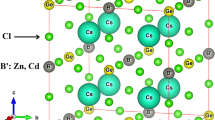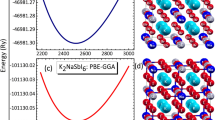Abstract
The existence of bio-accumulative lead hinders the commercialization of optoelectronic applications of Pb-based halide perovskites (PVKs). Therefore, researchers are seeking for comparative lead-free PVKs. Owing to the identical electronic configuration with Pb, Bi-based PVKs are proved to be one of the most promising candidates. Because strain is widely existed altering materials’ characteristics, it is crucial to study the influences of strain on the Bi-based PVKs. Our theoretical work investigates the strain influences on two kinds of Bi-based PVKs, i.e., Cs3Bi2Br9, and Cs2BiAgBr6. It is observed that both the tensile and compressive strains effectively change the crystal structures and the bandgaps, i.e., enlargement under tensile strain while shrinkage under compressive strain. Simultanously, the absorption spectra of these PVKs are also discussed. The strain study of Bi-based PVKs will offer guidance to the further development of lead-free PVKs.






Similar content being viewed by others
References
Liu Y, Yang Z, Liu SF (2018) Recent Progress in single-crystalline perovskite research including crystal preparation, property evaluation, and applications. Adv Sci (Weinh) 5(1):1700471. https://doi.org/10.1002/advs.201700471
**ao Z, Song Z, Yan Y (2019) From lead halide perovskites to lead-free metal halide perovskites and perovskite derivatives. Adv Mater 31(47):1803792. https://doi.org/10.1002/adma.201803792
Chatterjee S, Pal AJ (2018) Influence of metal substitution on hybrid halide perovskites: towards lead-free perovskite solar cells. J Mater Chem A 6:3793–3823. https://doi.org/10.1039/c7ta09943f
Attique S, Ali N, Ali S et al (2020) A potential checkmate to lead: bismuth in organometal halide perovskites, structure, properties, and applications. Adv Sci (Weinh) 7(13):1903143. https://doi.org/10.1002/advs.201903143
Zhao X-G, Yang D, Ren J-C, Sun Y, **ao Z, Zhang L (2018) Rational design of halide double perovskites for optoelectronic applications. Joule 2:1662–1673. https://doi.org/10.1016/j.joule.2018.06.017
Guo L, Xu G, Tang G, Fang D, Hong J (2020) Structural stability and optoelectronic properties of tetragonal MAPbI3 under strain. Nanotechnology 31(22):225204. https://doi.org/10.1088/1361-6528/ab7679
Martin LW, Chu YH, Ramesh R (2010) Advances in the growth and characterization of magnetic, ferroelectric, and multiferroic oxide thin films. Mater Sci Eng R Rep 68:89–133. https://doi.org/10.1016/j.mser.2010.03.001
Amorim B, Cortijo A, de Juan F et al (2016) Novel effects of strains in graphene and other two dimensional materials. Phys Rep 617:1–54. https://doi.org/10.1016/j.physrep.2015.12.006
Chen Y, Lei Y, Li Y et al (2020) Strain engineering and epitaxial stabilization of halide perovskites. Nature 577:209–215. https://doi.org/10.1038/s41586-019-1868-x
Al-Shami A, Lakhal M, Hamedoun M et al (2018) Tuning the optical and electrical properties of orthorhombic hybrid perovskite CH3NH3PbI3 by first-principles simulations: strain-engineering. Sol Energy Mater Sol Cells 180:266–270. https://doi.org/10.1016/j.solmat.2017.06.047
Wang S, Gong Z, Li G et al (2020) The strain effects in 2D hybrid organic-inorganic perovskite microplates: bandgap, anisotropy and stability. Nanoscale 12:6644–6650. https://doi.org/10.1039/d0nr00657b
Tu Q, Spanopoulos I, Hao S et al (2019) Probing Strain-induced band gap modulation in 2D hybrid organic-inorganic perovskites. ACS Energy Lett 4:796–802. https://doi.org/10.1021/acsenergylett.9b00120
**a M, Yuan J-H, Luo J et al (2020) Two-dimensional perovskites as sensitive strain sensors. J Mater Chem C 8:3814–3820. https://doi.org/10.1039/c9tc06437k
Soni A, Bhamu KC, Sahariya J (2020) Investigating effect of strain on electronic and optical properties of lead free double perovskite Cs2AgInCl6 solar cell compound: a first principle calculation. J Alloy Compd. https://doi.org/10.1016/j.jallcom.2019.152758
Yang E, Luo X (2020) Theoretical pressure-tuning bandgaps of double perovskites A2(BB’) X6 for photo-voltaics. Sol Energy 207:165–172. https://doi.org/10.1016/j.solener.2020.05.104
Perdew JP, Burke K, Ernzerhof M (1996) Generalized gradient approximation made simple. Phys Rev Lett 77(18):3865–3868. https://doi.org/10.1103/PhysRevLett.77.3865
Blöchl PE (1994) Projector augmented-wave method. Phys Rev B 50(24):17953–17979. https://doi.org/10.1103/PhysRevB.50.17953
Kresse G, Furthmüller J (1996) Efficient iterative schemes for ab initio total-energy calculations using a plane-wave basis set. Phys Rev B 54(16):11169–11186. https://doi.org/10.1103/PhysRevB.54.11169
Momma K, Izumi F (2011) VESTA 3 for three-dimensional visualization of crystal, volumetric and morphology data. J Appl Crystallogr 44:1272–1276. https://doi.org/10.1107/S0021889811038970
Nelson RD, Santra K, Wang Y, Hadi A, Petrich JW, Panthani MG (2018) Synthesis and optical properties of ordered-vacancy perovskite cesium bismuth halide nanocrystals. Chem Commun (Camb) 54:3640–3643. https://doi.org/10.1039/c7cc07223f
Lou Y, Fang M, Chen J, Zhao Y (2018) Formation of highly luminescent cesium bismuth halide perovskite quantum dots tuned by anion exchange. Chem Commun (Camb) 54:3779–3782. https://doi.org/10.1039/c8cc01110a
Gao M, Zhang C, Lian L et al (2019) Controlled synthesis and photostability of blue emitting Cs3Bi2Br 9 perovskite nanocrystals by employing weak polar solvents at room temperature. J Mater Chem C 7:3688–3695. https://doi.org/10.1039/c9tc00400a
Luo T, Wei J (2020) First principles study of electronic and optical properties of inorganic and lead-free perovskite: Cs3Bi2X9 (X: Cl, Br, I). Mater Chem Phys. https://doi.org/10.1016/j.matchemphys.2020.123374
Luo Z, Li Q, Zhang L et al (2020) 0D Cs3 Cu2 X5 (X = I, Br, and Cl) nanocrystals: colloidal syntheses and optical properties. Small 16(3):1905226. https://doi.org/10.1002/smll.201905226
Zhu D, Zaffalon ML, Pinchetti V et al (2020) Bright Blue emitting Cu-doped Cs2ZnCl4 colloidal nanocrystals. Chem Mater 32:5897–5903. https://doi.org/10.1021/acs.chemmater.0c02017
Li Q, Yin L, Chen Z et al (2019) High Pressure structural and optical properties of two-dimensional hybrid halide perovskite (CH3NH3)3Bi2Br 9. Inorg Chem 58:1621–1626. https://doi.org/10.1021/acs.inorgchem.8b03190
Slavney AH, Hu T, Lindenberg AM, Karunadasa HI (2016) A bismuth-halide double perovskite with long carrier recombination lifetime for photovoltaic applications. J Am Chem Soc 138:2138–2141. https://doi.org/10.1021/jacs.5b13294
Jacobs R, Luo G, Morgan D (2019) Materials Discovery of stable and nontoxic halide perovskite materials for high-efficiency solar cells. Adv Func Mater. https://doi.org/10.1002/adfm.201804354
Li Q, Wang Y, Pan W et al (2017) High-Pressure band-gap engineering in lead-free Cs2 AgBiBr 6 double perovskite. Angew Chem Int Ed Engl 56:15969–16189. https://doi.org/10.1002/anie.201708684
Amin B, Ahmad I, Maqbool M, Goumri-Said S, Ahmad R (2011) Ab initio study of the bandgap engineering of Al1−xGaxN for optoelectronic applications. J Appl Phys 109(2):023109. https://doi.org/10.1063/1.3531996
Fox M (2001) Optical Properties of Solids. Oxford University Press, New York
Acknowledgements
This work is supported by the National Natural Science Foundation of China (Nos. U1737109, 11933006) and the Key Research and Development Program of Zhejiang Province, China (No. 2020C01120).
Author information
Authors and Affiliations
Corresponding author
Ethics declarations
Conflict of interest
The authors declare no conflicts of interest.
Additional information
Handling Editor: Yaroslava Yingling.
Publisher's Note
Springer Nature remains neutral with regard to jurisdictional claims in published maps and institutional affiliations.
Rights and permissions
About this article
Cite this article
Wang, X., Bi, G., Ali, N. et al. Theoretical study of the strain influence on lead-free bismuth-based halide perovskites. J Mater Sci 56, 11377–11385 (2021). https://doi.org/10.1007/s10853-021-06025-7
Received:
Accepted:
Published:
Issue Date:
DOI: https://doi.org/10.1007/s10853-021-06025-7




